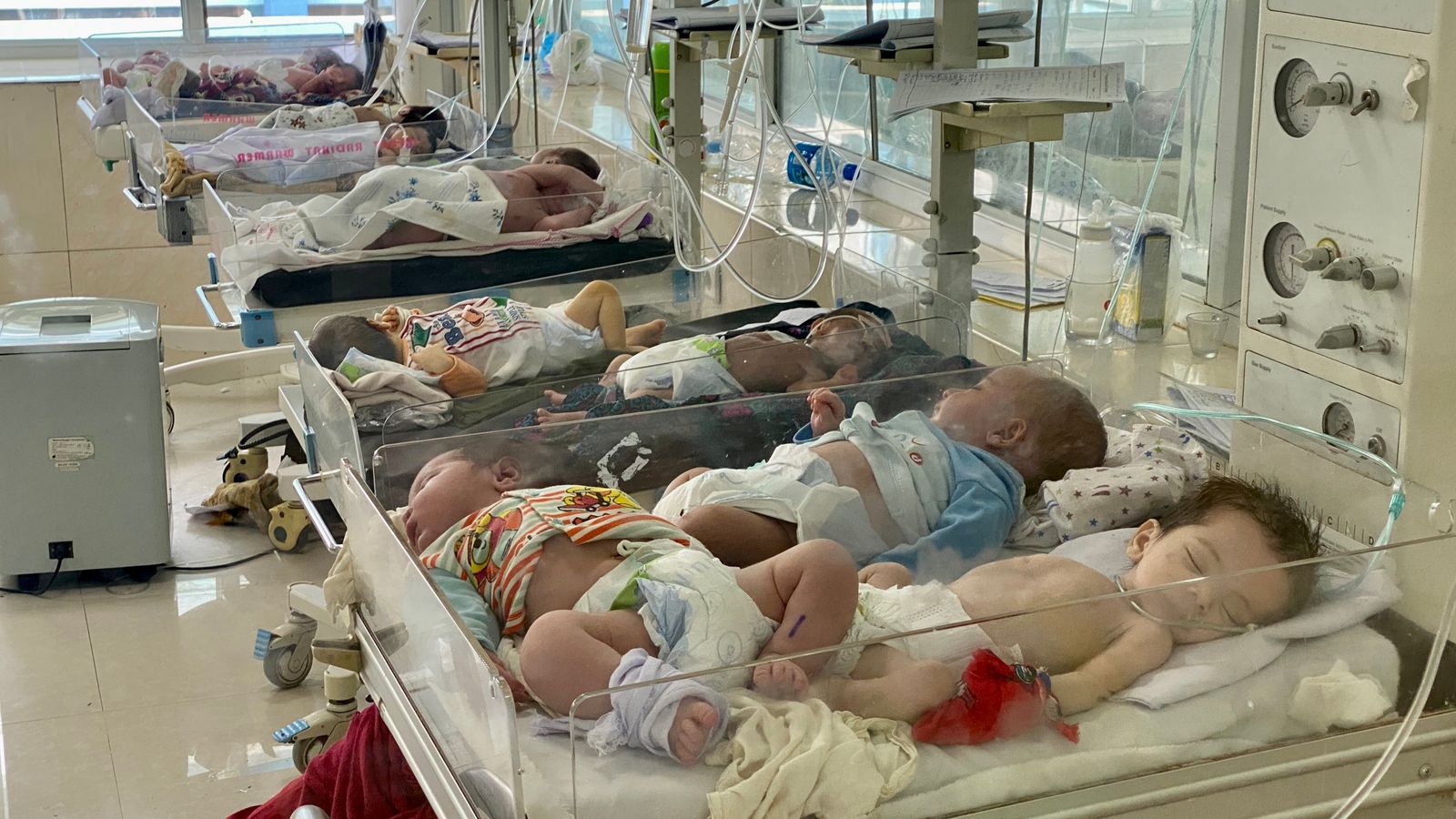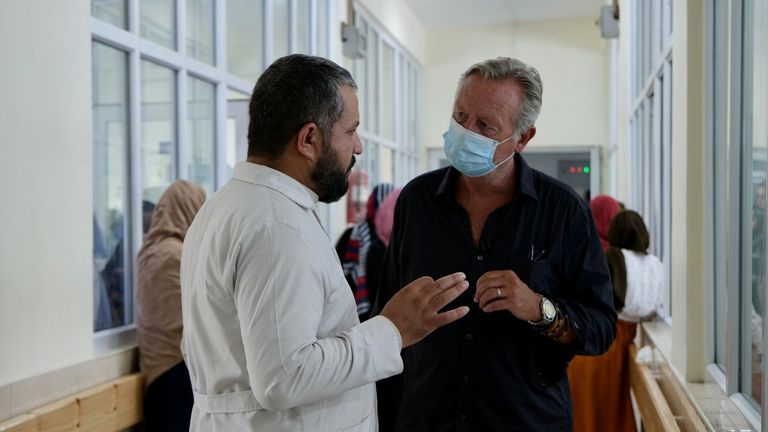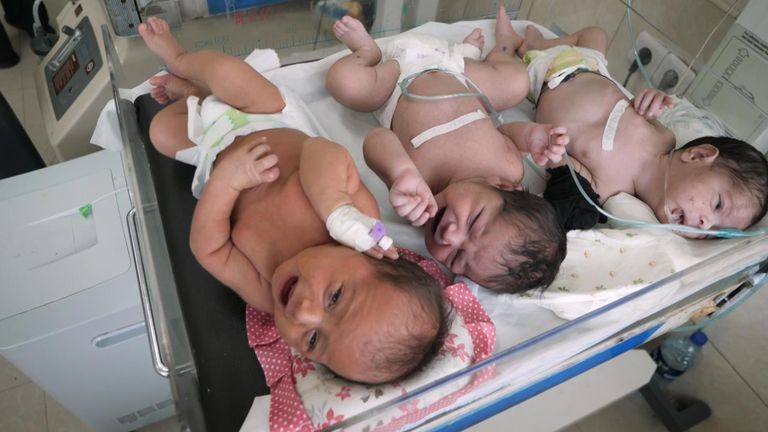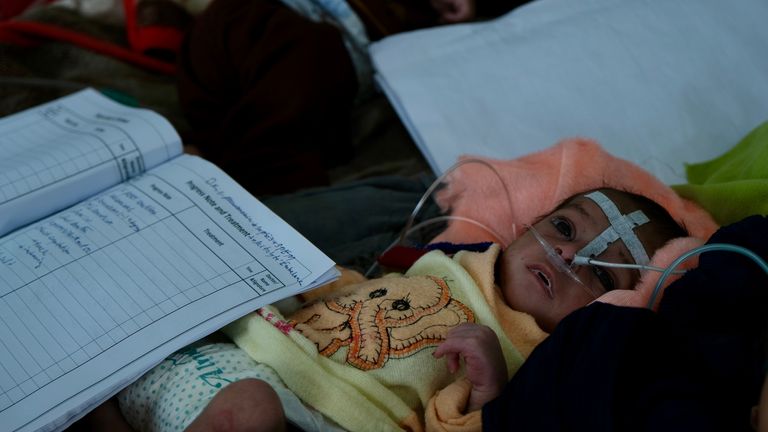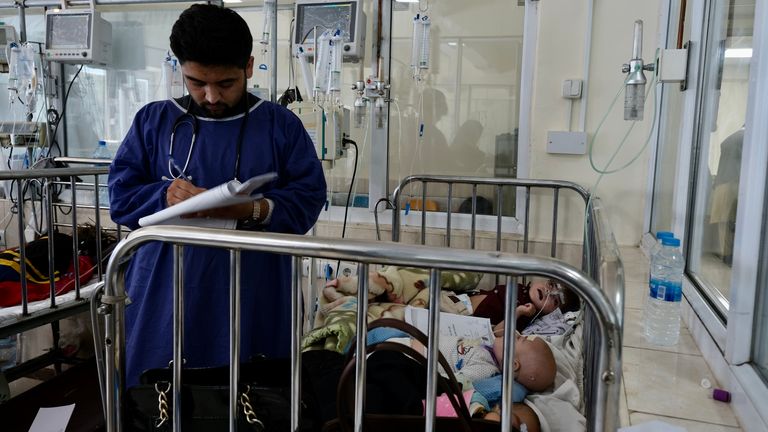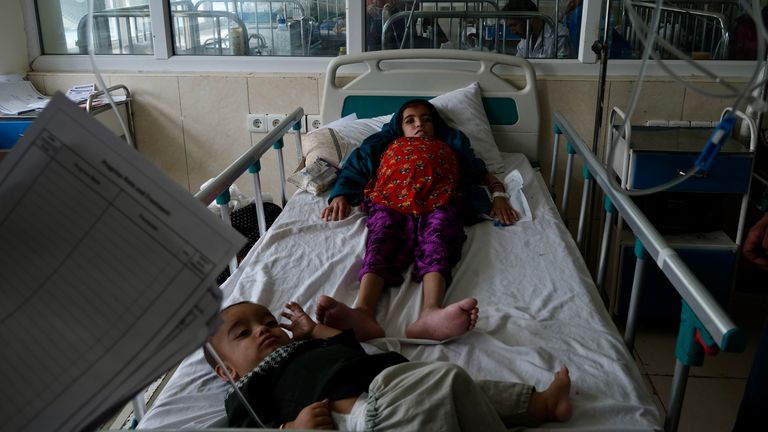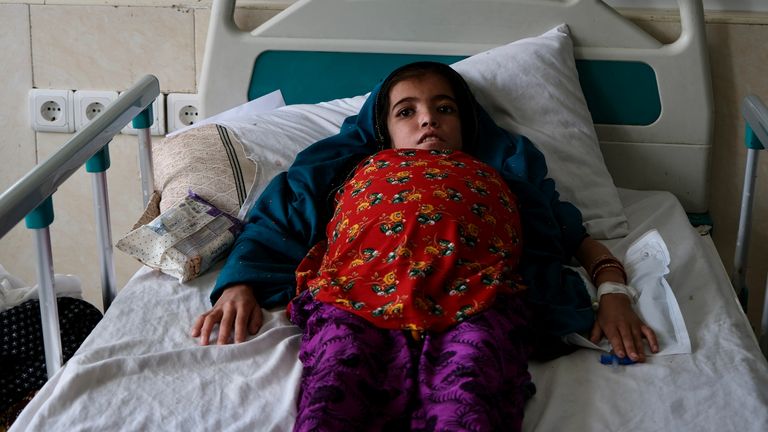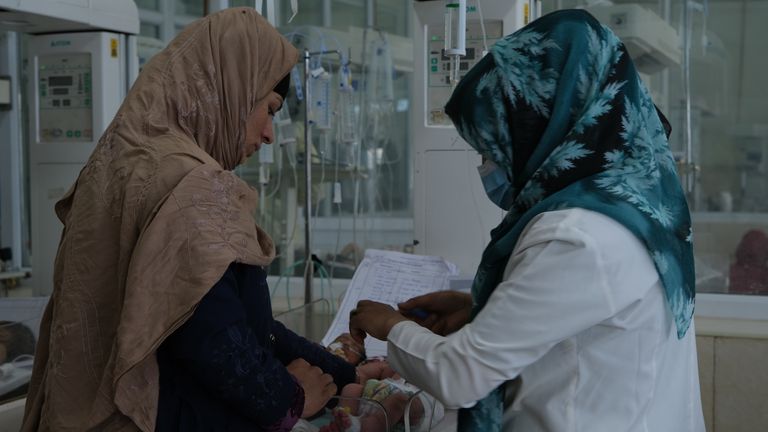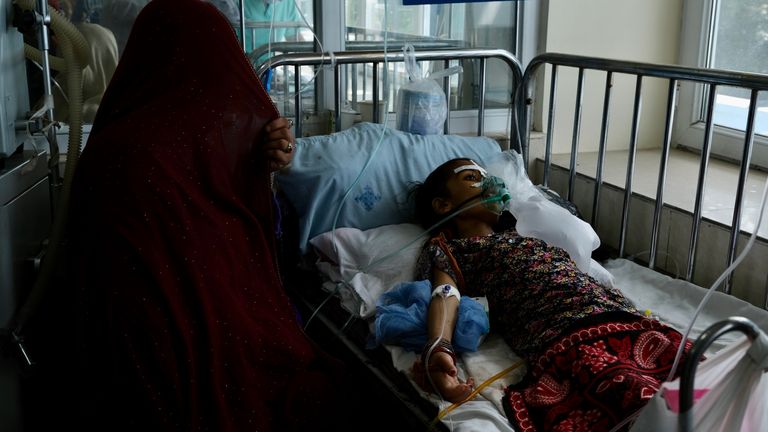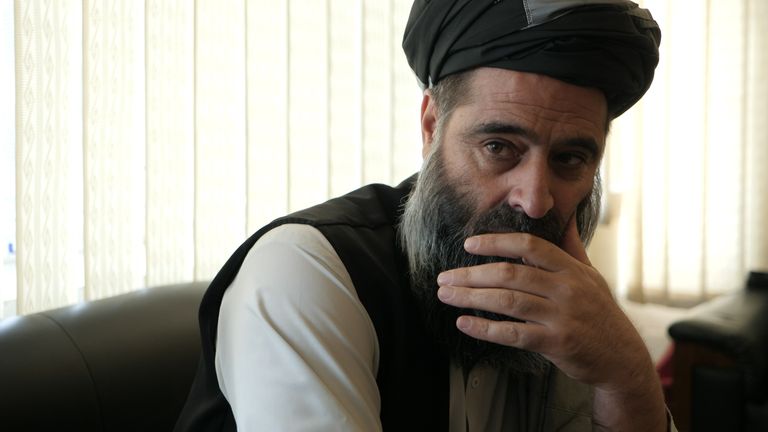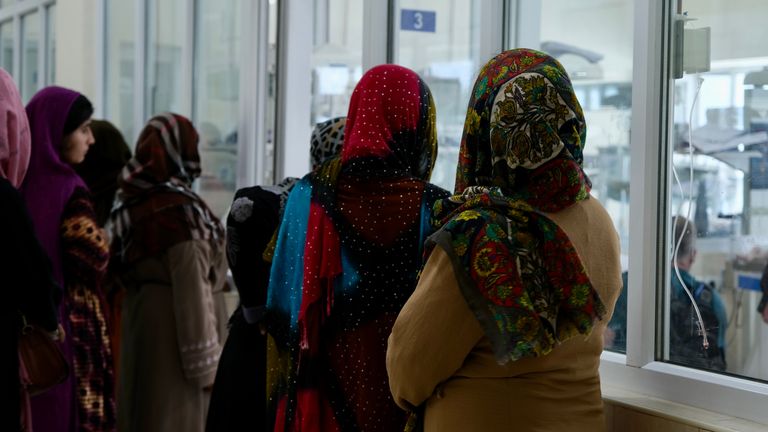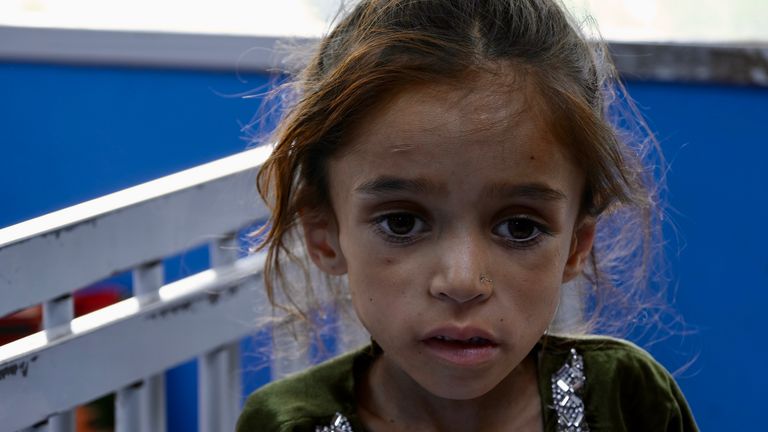With his long black hair flowing beneath a traditional cap and over his masked face, a Taliban guard, machine gun in hand, indicated I should follow the doctor.
I realised then we were to have his company for the duration of our stay.
A peculiar development and an unusual experience, but one that was to be dwarfed by what we were about to see in the heart of Afghanistan‘s largest and best children’s hospital, in the centre of the capital Kabul.
“We have many wards that I need to show you,” Muhammad Iqbal, the head of doctors, at the Indira Gandhi Children’s Hospital said, leading me up a series of stairs.
“The first wards are intensive care and critical care, follow me.”
We entered the corridors leading to the wards, groups of women – mothers – immediately covered their faces, moving aside or looking for somewhere to stand out of the way.
I could hear the crying children from down the corridor and as I peered through the windows of the wards, I was taken aback by the sheer number being treated.
The ward wasn’t just full, it was bursting. Baby cots designed for one child had two or three squeezed in together.
Doctors and nurses buzzed around the room, checking vital signs, and trying to soothe the crying babies.
I’ve seen such poor medical facilities in 20 years of reporting from Afghanistan, I assumed I couldn’t be shocked. In the provinces of the country, basic medical care has been the norm for decades.
It wasn’t the condition the children were being kept in, it wasn’t really the numbers of children – many desperately ill – it was the fact that this is happening in the very best state hospital in the whole of the country.
Worse still, was the testimony of doctor after doctor that they can’t keep children with treatable diseases alive because even here they haven’t got enough medicine, supplies, or equipment to care for their patients properly.
Afghanistan is in the midst of a medical crisis that is worsening by the day, exacerbated by an economy in freefall, the freezing of the country’s assets, and the drying up of hundreds of millions of dollars of aid that flowed here for two decades, because the Taliban has taken control.
The Indira Gandhi hospital is testament to this.
There are over 500 patients being treated at this hospital – they’ve room for 300.
The hospital nearly shut down last winter, but an injection of aid from the International Committee of the Red Cross provided much needed immediate relief and resource – but it’s not nearly enough.
Ward after ward is the same, jam packed with really poorly infants and children.
“Eighty percent of middle-class families used to go to private hospitals for treatment, now they came here, they can’t afford to go anywhere else,” Dr Muhammad Iqbal told me.
“There’s a need for some good drugs you don’t purchase from outside a hospital, this is the problem, our people are very poor.
“There’s a need for ventilators, we don’t have ventilators, CPAP machines, and this is a very [big] need for an ICU.”
In one cot, three children, Baheer, Mehrama and Sahar, all have cerebral palsy, along with other medical complications.
“This one is CP, this one is CP, this one is CP… three of them CP, cerebral palsy,” their doctor explained pointing at each of their near lifeless bodies.
“It’s serious”, Dr Salahuddin adds.
Their chances of survival are low, there is no treatment for cerebral palsy available in Afghanistan.
Aziz Ullah struggles to pick his 16-year-old daughter Muslimah up out of her wheelchair and place her next to her brother, who’s aged just one.
They looked for help and medical treatment in two other provinces, Zabul and Kandahar, before they came here.
Subscribe to Out Of Afghanistan on Apple Podcasts, Spotify and Spreaker
Both children have a genetic kidney disease.
“I’m worried for her,” Aziz tells me in a gentle voice.
“The doctors told me the disease recently developed in her, this is my fourth child with this condition.”
Like two of his children who have already died, Muslimah and her brother Mansoor Ahmad’s chances of survival are already slim.
“The chance of [survival] is too low, I mean 80 percent chance of dying,” Dr Sharif Ahmed Azizi explained.
“We can do nothing, no, because we don’t have any facilities for these patients.
“For the poor patients we don’t have any good resources for the patients, because from one side we have got more patients. I mean the load of patients is too high, from every side of Afghanistan comes the patients here, and the facilities too low.”
I asked him how it felt to come to work every day knowing there is little they can do for children like Muslimah.
“Unfortunately, we can do nothing for these patients, for these kinds of patients… there is no other way.”
Many of the children being cared for have serious illnesses that could be successfully treated.
Staring from her hospital bed into the distance, with her mum sitting next to her, 12-year-old Amina has cerebral meningitis.
They’re struggling to keep her alive. It’s not a lack of skill here, it’s a lack of resources.
The hospital was spotless – and wherever we looked it was clear that the doctors, nurses, and hospital staff were very dedicated.
But without the very basic resources it needs, it’s on its knees.
At one point we were separated from Dr Iqbal, I went to see if he had been called to his office. I asked one of the staff if the senior doctor was there. After a few moments, he gestured for me to follow him inside another office.
Inside were two black-turbaned, long bearded men, clearly hardcore Taliban, sitting and talking.
I apologised for intruding and said I was looking for the senior doctor and prepared to make my exit.
“I am a doctor, in fact I am a specialist surgeon, and I am in charge here,” one of the men said in perfect English.
“You are welcome.”
Never make any assumptions in Afghanistan, I reminded myself.
Dr Muhammad Haseeb Wardak is the hospital’s president.
He agreed to a quick interview, and I asked him if they needed international money to help with the hospital’s problems.
“We are calling on the international community to increase their support to us and continue this support,” he told me.
“They (the United States) should unfreeze our money, this is our hope, our demand.”
“This hospital has been here for 50 years, and we want more facilities at the hospital, and we need more staff and equipment, so we can treat patients who come here from all over Afghanistan,” he added.
The impasse between the Taliban and the international community over human rights, particularly women’s rights, continues to be a major sticking point. And it’s at the root of much of the country’s problems.
As we walked the corridors of the hospital, a woman grabbed us. She wanted help to buy baby formula for her seven-month-old daughter, Fatima.
Wearing the traditional blue Afghan burqa, she looked straight at me and begged for help.
That is unusual in today’s Afghanistan – for a woman to engage so directly with a man, especially one accompanied by an armed Taliban guard, in a public place.
It indicates just how desperate she is.
Malnutrition across Afghanistan is out of control. This hospital has had to expand its malnutrition ward to treat more and more young patients.
The worst affected come here from all over the country – if they can make it.
Seven-year-old Safiya has just arrived with her family. They’ve travelled from Paktia Province, around six hours drive from Kabul.
Safiya is severely underweight. Her face is skeletal, she struggles to sit up on the hospital bed.
But for the first time in weeks, the family has hope. Her condition is improving after just one day here.
“I am hopeful,” her mother told me. “She is already much better than she was before we arrived.”
But for many other parents in the malnutrition ward, there is nothing but despair.
With his mother weeping at his bedside, tiny two-year-old Shereen Khan lies motionless on his side. He has what appeared to be bed sores all over his back, and tubes attached to his nose.
His mother Gulbashra, a cleaner from Helmand Province, is terribly poor.
Choking back tears, she explains her little boy, her only child, started to get ill four months ago, but she had to leave him at home to go to work.
Shereen deteriorated, and she is keeping a constant vigil at his bedside, hoping he pulls through.
Like so many in Afghanistan, Gulbashra doesn’t care who’s to blame – she just wants her son to live.
